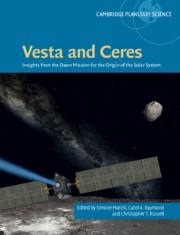Book contents
- Vesta and Ceres: Insights from the Dawn Mission for the Origin of the Solar System
- Cambridge Planetary Science
- Vesta and Ceres
- Copyright page
- Contents
- Contributors
- Preface
- Part I Remote Observations and Exploration of Main Belt Asteroids
- Part II Key Results from Dawn’s Exploration of Vesta and Ceres
- Part III Implications for the Formation and Evolution of the Solar System
- 13 Formation of Main Belt Asteroids
- 14 Isotopic Constraints on the Formation of the Main Belt
- 15 Origin and Dynamical Evolution of the Asteroid Belt
- 16 Collisional Evolution of the Main Belt as Recorded by Vesta
- 17 Epilogue
- Index
- Plate Section (PDF Only)
- References
16 - Collisional Evolution of the Main Belt as Recorded by Vesta
from Part III - Implications for the Formation and Evolution of the Solar System
Published online by Cambridge University Press: 01 April 2022
- Vesta and Ceres: Insights from the Dawn Mission for the Origin of the Solar System
- Cambridge Planetary Science
- Vesta and Ceres
- Copyright page
- Contents
- Contributors
- Preface
- Part I Remote Observations and Exploration of Main Belt Asteroids
- Part II Key Results from Dawn’s Exploration of Vesta and Ceres
- Part III Implications for the Formation and Evolution of the Solar System
- 13 Formation of Main Belt Asteroids
- 14 Isotopic Constraints on the Formation of the Main Belt
- 15 Origin and Dynamical Evolution of the Asteroid Belt
- 16 Collisional Evolution of the Main Belt as Recorded by Vesta
- 17 Epilogue
- Index
- Plate Section (PDF Only)
- References
Summary
Vesta’s surface is dominated by two overlapping impact basins: the older ~400 km Veneneia basin and the younger ~500 km diameter Rheasilvia basin.Their age and nature, along with the ejecta they produced in the form of V-type asteroids, can help us probe Vesta’s evolution.By modeling the production of craters superposed on these basins or on features created by their formation, we predict Veneneia and Rheasilvia basins are 3.2–3.5 Ga and ~1 Ga, respectively. Numerical models indicate they were created by the impact of ~60–70 km projectiles. These impacts likely dredged up material formed at >50 km depths within Vesta. The evidence for the formation time of Veneneia and Rheasilvia in the eucrite and howardite meteorite record exists but is limited. The absence of an obvious spike of 40Ar/39Ar shock degassing ages may be a consequence of low Main Belt impact velocities (< 5 km/s). Most V-type asteroids in the inner main belt are ejecta from one of these two basins. The scattered and limited population of V-types in the central and outer main belt have no clear source. We postulate they are fragments from Vesta-like bodies that originally formed in the terrestrial planet region.
Keywords
- Type
- Chapter
- Information
- Vesta and CeresInsights from the Dawn Mission for the Origin of the Solar System, pp. 250 - 261Publisher: Cambridge University PressPrint publication year: 2022
References
- 1
- Cited by

